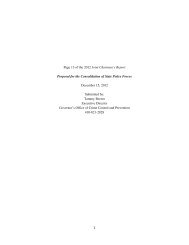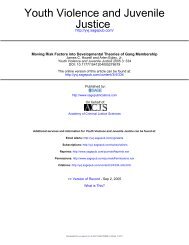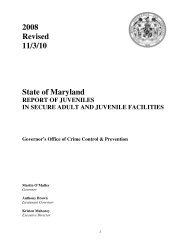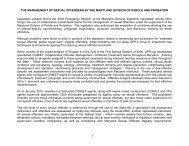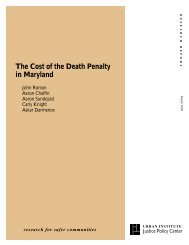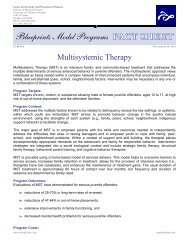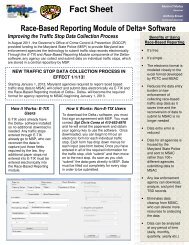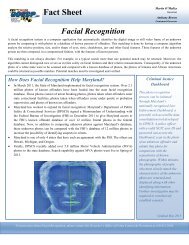Targeted Outreach - Governor's Office of Crime Control & Prevention ...
Targeted Outreach - Governor's Office of Crime Control & Prevention ...
Targeted Outreach - Governor's Office of Crime Control & Prevention ...
You also want an ePaper? Increase the reach of your titles
YUMPU automatically turns print PDFs into web optimized ePapers that Google loves.
Appendices 61<br />
Appendix B<br />
Survey Sample at Baseline and Follow-Up<br />
In order to learn about the youth in GPTTO and GITTO,<br />
Club staff administered a survey to new youth when they<br />
first started coming to the Club. A total <strong>of</strong> 456 youth were<br />
surveyed as they entered the Club/project.<br />
The baseline survey consisted <strong>of</strong> questions about the background<br />
characteristics <strong>of</strong> the youth, including gender, age,<br />
ethnicity/race and socio-economic status (SES); school<br />
information, such as grade in school, dropout status,<br />
grades received, homework completion and academic efficacy;<br />
neighborhood perception, including gang prevalence;<br />
acting out and delinquent behavior, including<br />
fighting, drug and alcohol use, street crimes, gang activity,<br />
arrest rates and probation status; involvement in outside<br />
activities and with supportive adults; peers and peer group;<br />
and reasons for attending the Boys & Girls Club and prior<br />
participation at the Club (see Appendix C for specific constructs<br />
and reliabilities).<br />
The baseline survey was also administered to a sample <strong>of</strong><br />
399 comparison youth who lived in the same communities<br />
as the target youth. Comparison youth were recruited<br />
separately for Clubs implementing intervention and prevention<br />
strategies and were identified through public and<br />
alternative schools, other youth-serving organizations,<br />
police and probation.<br />
Comparison Youth versus Target Youth<br />
Although comparison youth were selected to match Target<br />
youth on age, gender and ethnicity, they were less successfully<br />
matched in terms <strong>of</strong> their risky behaviors. Analyses<br />
comparing Target Youth with comparison youth revealed<br />
significant differences at baseline on a number <strong>of</strong> behaviors,<br />
summarized in Table B.1.<br />
Follow-Up Interviews and Attrition Rates<br />
Youth recruited through the targeted outreach programs<br />
and those recruited as comparison youth went through a<br />
follow-up interview one year after the baseline survey. The<br />
follow-up survey included questions similar to those<br />
included on the baseline survey plus questions about the<br />
youth’s experiences at the Clubs or in the intervention<br />
projects. Macro International, Inc. was subcontracted to<br />
conduct the follow-up interview with the youth.<br />
Four Clubs had completed questionnaires with fewer than<br />
23 youth due to issues such as limited new recruitment in<br />
their second year <strong>of</strong> implementation, challenges getting<br />
permission slips returned, administering the surveys and<br />
high rates <strong>of</strong> staff turnover. These Clubs were not included<br />
in the follow-up sample.<br />
Attrition<br />
Across the remaining seven Clubs, there were 377 treatment<br />
youth and 387 comparison youth surveyed at baseline: 302<br />
<strong>of</strong> the 377 treatment youth (80%) participated in both the<br />
baseline and follow-up surveys; 264 <strong>of</strong> the 387 comparison<br />
youth (68%) completed both surveys. Given the attrition<br />
from baseline to follow-up, we investigated the comparability<br />
<strong>of</strong> the baseline sample and the follow-up sample. We conducted<br />
statistical tests to explore whether there was a<br />
difference between those who participated on the follow-up<br />
survey and those who did not with respect to gender, race,<br />
age and gang risk factor score at baseline. The differences<br />
are reported below.<br />
<strong>Prevention</strong> Youth<br />
There were 292 prevention youth surveyed at baseline,<br />
236 <strong>of</strong> whom also participated in the one-year follow-up<br />
survey (81%). Among comparison prevention youth, 297<br />
were surveyed at baseline, and 216 also responded at<br />
follow-up (73%).<br />
For the prevention youth, the only significant difference<br />
between baseline-only versus two-wave completers was age.<br />
The mean age for those who completed both surveys was<br />
11.91, while those who completed only the baseline survey<br />
were older on average, 13.18 years old (p



